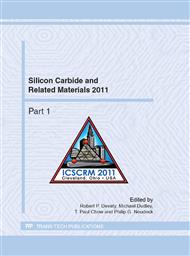p.1265
p.1269
p.1275
p.1279
p.1283
p.1287
p.1291
p.1295
p.1299
Fabrication of Silicon Carbide Thin Film as a Stabilizing Layer for Improving the Stability of Porous Silicon Photodiodes
Abstract:
This paper investigates the effect of silicon carbide (SiC) thin film as a stabilizing layer on porous silicon (PS) in metal–semiconductor–metal (MSM) photodiodes. Photo-assisted pulsed electrochemical etching method was used to produce the PS layers with large pore density and small crystallite size. As–prepared PS surface was modified with acetylene gas flow in a thermal process (750°C) in order to replace the hydrogen termination by Si–C bonds which is more stable. During the thermal carbonization, carbon atoms penetrated into the silicon lattice forming a thin (~4 nm) SiC layer. Because of high inertness of silicon carbide thin film, thermally carbonized porous silicon layer (TC-PS) was found to be more stable than the freshly prepared PS surfaces. A small reduction in specific surface area was found after carbonization which is due to the small size of acetylene molecules. The FTIR measurements confirmed the presence of SiC bonds in the TC-PS sample. The photocurrent of the fabricated photodiodes based on as-grown PS was lowered under prolonged green laser radiation (532nm, 5mW), but devices based on TC-PS showed more stable I-V characteristics under the same condition even for 120 min of laser exposure.
Info:
Periodical:
Pages:
1283-1286
Citation:
Online since:
May 2012
Authors:
Price:
Сopyright:
© 2012 Trans Tech Publications Ltd. All Rights Reserved
Share:
Citation:


